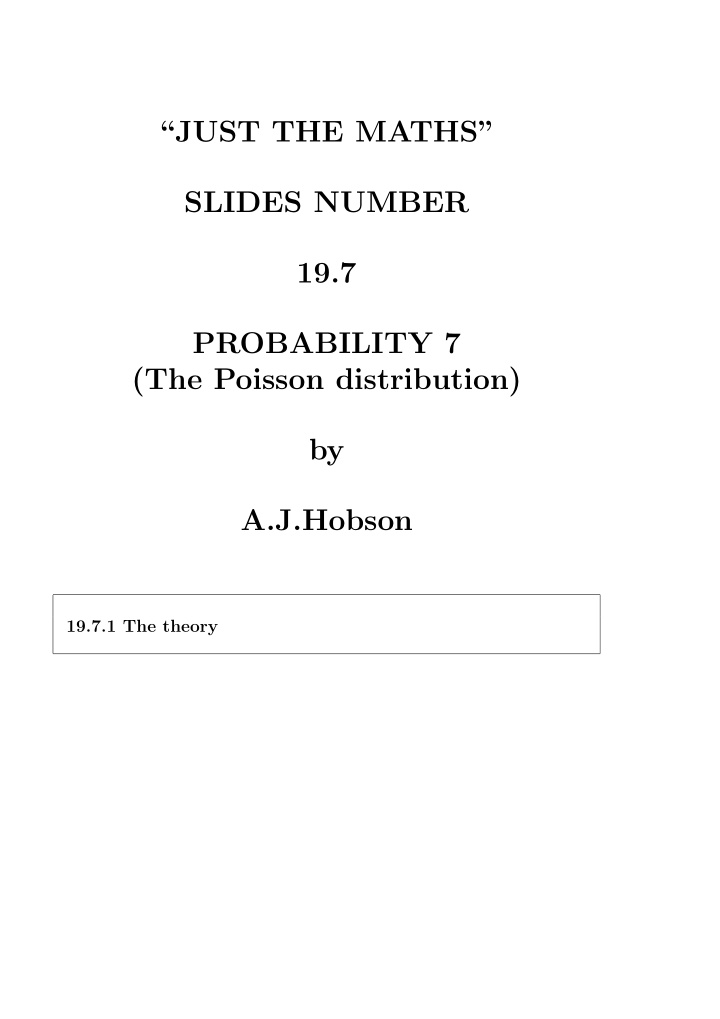



“JUST THE MATHS” SLIDES NUMBER 19.7 PROBABILITY 7 (The Poisson distribution) by A.J.Hobson 19.7.1 The theory
UNIT 19.7 - PROBABILITY 7 THE POISSON DISTRIBUTION 19.7.1 THE THEORY We recall that, in a binomial distribution of n trials, the probability, P r , that an event occurs exactly r times out of a possible n is given by n ! ( n − r )! r ! p r q n − r , P r = where p is the probability of success in a single trial and q = 1 − p is the probability of failure. Now suppose that n is very large compared with r and that p is very small compared with 1. Then, (a) n ! ( n − r )! = n ( n − 1)( n − 2) ..... ( n − r + 1) ≃ n r . 1
ILLUSTRATION If n = 120 and r = 3, then ( n − r )! = 120! n ! 117! = 120 × 119 × 118 ≃ 120 3 . (b) q r = (1 − p ) r ≃ 1 , so that q n − r ≃ q n = (1 − p ) n . We may deduce that P r ≃ n r p r (1 − p ) n = ( np ) r (1 − p ) n r ! r ! or P r ≃ ( np ) r 1 − np + n ( n − 1) p 2 − n ( n − 1)( n − 2) p 3 + . . r ! 2! 3! ≃ ( np ) r 1 − np + ( np ) 2 − ( np ) 3 + . . . r ! 2! 3! 2
Hence, P r ≃ ( np ) r r ! e − np . The number, np , in this formula is of special significance, being the average number of successes to be expected a single set of n trials. If we denote np by µ , we obtain the “Poisson distribution” formula, P r ≃ µ r e − µ r ! Notes: (i) Although the formula has been derived from the bi- nomial distribution, as an approximation, it may also be used in its own right, in which case we drop the approxi- mation sign. (ii) The Poisson distribution is more use than the bino- mial distribution when n is a very large number, the bi- nomial distribution requiring the tedious evaluation of its various coefficients. (iii) The Poisson distribution is of particular use when the average frequency of occurrence of an event is known, but not the number of trials. 3
EXAMPLES 1. The number of cars passing over a toll-bridge during the time interval from 10a.m. until 11a.m. is 1,200. (a) Determine the probability that not more than 4 cars will pass during the time interval from 10.45a.m. until 10.46a.m. (b) Determine the probability that 5 or more cars pass during the same interval. Solution The number of cars which pass in 60 minutes is 1200 so that the average number of cars passing, per minute, is 20 = µ . (a) The probability that not more than 4 cars pass in a one-minute interval is the sum of the probabilities for 0,1,2,3,4 cars. That is, (20) r e − 20 4 = � r ! r =0 (20) 0 + (20) 1 + (20) 2 + (20) 3 + (20) 4 e − 20 = 0! 1! 2! 3! 4! 8221 e − 20 ≃ 1 . 69 × 10 − 5 . 4
(b) The probability that 5 or more cars will pass in a one-minute interval is the probability of failure in (a). In other words, (20) r e − 20 4 1 − = � r ! r =0 1 − 8221 e − 20 ≃ 0 . 99998 2. A company finds that, on average, there is a claim for damages which it must pay 7 times in every 10 years. It has expensive insurance to cover this situation. The premium has just been increased, and the firm is considering letting the insurance lapse for 12 months as it can afford to meet a single claim. Assuming a Poisson distribution, what is the proba- bility that there will be at least two claims during the year ? Solution Using µ = 7 10 = 0 . 7, the probability that there will be at most one claim during the year is given by P 0 + P 1 = e − 0 . 7 + e − 0 . 7 0 . 7 = e 0 . 7 (1 + 0 . 7) . 5
The probability that there will be at least two claims during the year is given by 1 − e − 0 . 7 (1 + 0 . 7) ≃ 0 . 1558 3. There is a probability of 0.005 that a welding machine will produce a faulty joint when it is operated. The machine is used to weld 1000 rivets. Determine the probability that at least three of these are faulty. Solution First, we have µ = 0 . 005 × 1000 = 5. Hence the probability that at most two will be faulty is given by 5 0 0! + 5 1 1! + 5 2 P 0 + P 1 + P 2 = e − 5 . 2! That is, e − 5 [1 + 5 + 12 . 5] ≃ 0 . 125 Hence, the probability that at least three will be faulty is approximately 1 − 0 . 125 = 0 . 875 6
Recommend
More recommend